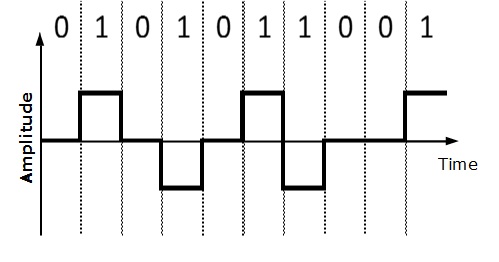
Bipolar Line Encoding: Understanding AMI and Pseudo Ternary Schemes
Introduction to Bipolar Line Encoding
In modern digital telecommunications systems, effective data transmission is essential for seamless communication. Bipolar line encoding, a widely used method, enables efficient data transmission by converting digital data into electrical signals. Two popular schemes within bipolar line encoding are Alternate Mark Inversion (AMI) and Pseudo Ternary. In this article, we will delve into these schemes, illustrate their waveforms, and analyze the presence or absence of DC Component and Baseline Wandering.
Understanding AMI Scheme
Alternate Mark Inversion (AMI) is a bipolar line encoding scheme that employs three voltage levels: positive, negative, and zero, representing binary ‘1’, binary ‘0’, and no signal, respectively. The key feature of AMI is the alternate inversion of consecutive marks, which helps in clock synchronization and reduces the presence of a DC component in the signal.
AMI Waveform Representation:
Data: 1 0 0 1 1 0 0 1
Encoding: + 0 0 - + 0 0 +Presence/Absence of DC Component and Baseline Wandering in AMI:
Presence of DC Component: AMI ensures the absence of a DC component by alternating the polarity of consecutive marks. This means that over time, the average voltage level of the signal converges to zero, reducing any long-term DC bias.
Baseline Wandering: While baseline wandering is still possible in AMI, it occurs less frequently due to the presence of alternating marks. Baseline wandering may occur when there are long sequences of ‘0’s without any ‘1’s, causing synchronization challenges.
Understanding Pseudo Ternary Scheme
In the Pseudo Ternary scheme, three voltage levels are also used: positive, negative, and zero, representing binary ‘0’, binary ‘1’, and no signal transition, respectively. Unlike AMI, Pseudo Ternary encodes a binary ‘0’ with a signal transition and a binary ‘1’ without any signal transition.
Pseudo Ternary Waveform Representation:
Data: 1 0 0 1 1 0 0 1
Encoding: - + + - - + + -Presence/Absence of DC Component and Baseline Wandering in Pseudo Ternary:
Presence of DC Component: Pseudo Ternary encoding inherently has a DC component because the distribution of positive and negative voltage levels is equal. This means that the average voltage level does not converge to zero, leading to the presence of DC bias in the signal.
Baseline Wandering: Baseline wandering can occur in Pseudo Ternary, particularly when there are consecutive ‘1’s without any signal transitions. These prolonged sequences of ‘1’s can cause the baseline to wander and create synchronization challenges.
Conclusion
Bipolar line encoding plays a crucial role in digital data transmission for telecommunications systems. The AMI scheme, with its alternate inversion of consecutive marks, ensures no DC component and reduced baseline wandering. It offers reliable and efficient data transmission for various applications. On the other hand, the Pseudo Ternary scheme, while also effective, has an inherent DC component due to an equal distribution of positive and negative voltage levels.
Choosing between AMI and Pseudo Ternary depends on specific system requirements, such as the need to manage DC component and baseline wandering. Ultimately, understanding these bipolar line encoding schemes empowers telecommunication engineers to make informed decisions, ensuring optimized data transmission and reliable communication.